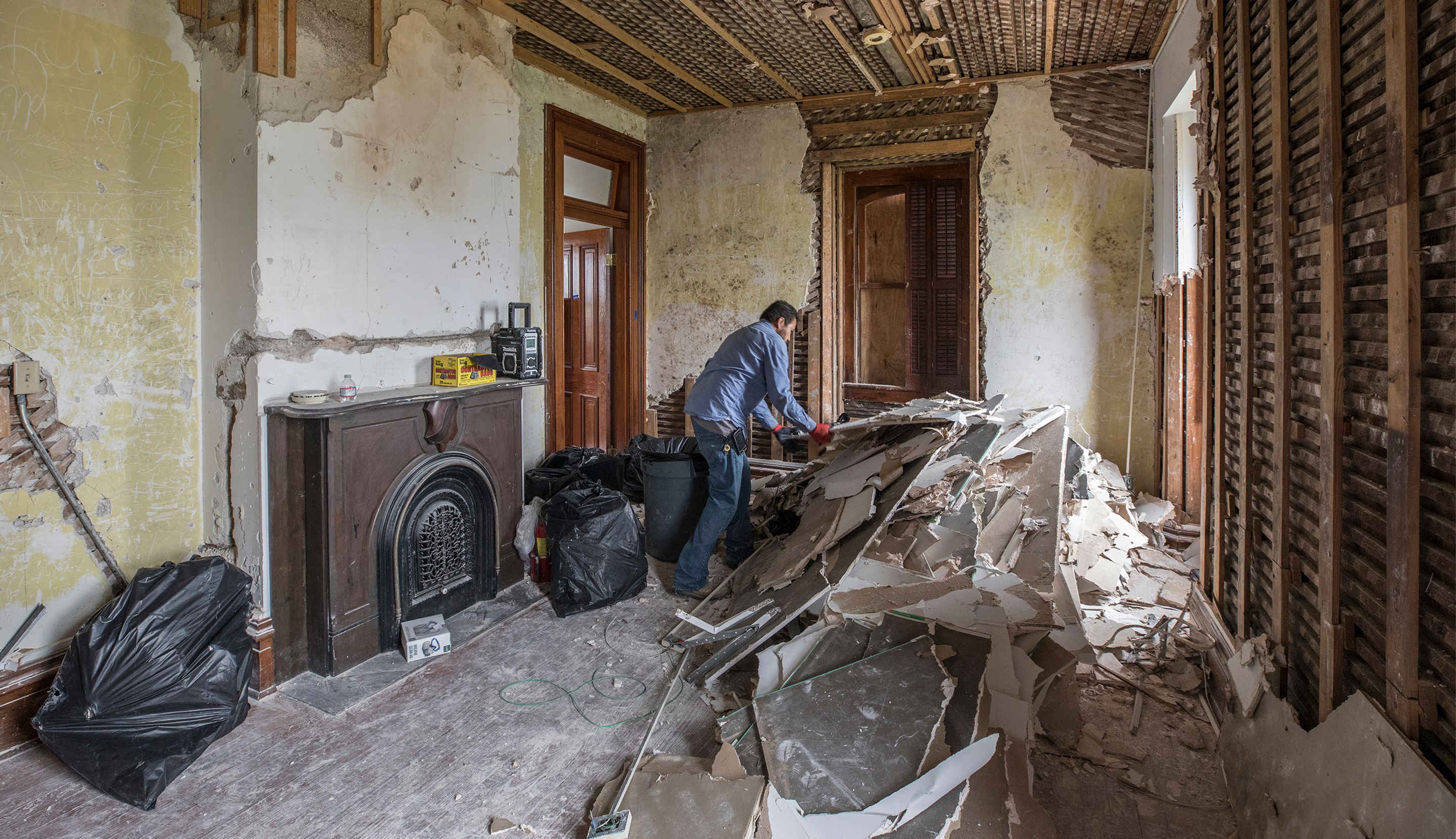
When natural disasters strike, the Texas Historical Commission (THC) is ready to provide assistance to historic properties and resources that are impacted. This support comes in the form of surveying affected areas, administering the regulatory review process, managing grants, and providing materials to assist property owners and museums with impacted collections or buildings.
Natural Disasters in Texas
Hurricane Harvey made landfall as a Category 4 storm near Rockport on August 25, 2017. Nearby wind gusts topped 100 miles per hour, leading to widespread destruction of homes and buildings. Pounding waves on top of Harvey’s storm surge inundated parts of the Texas Coastal Bend, damaging some areas. Harvey’s extremely slow movement kept a surge of moisture in southeast Texas for days, causing catastrophic flooding and one of the worst weather disasters in U.S. history. Harvey caused unprecedented damage to Texas’ housing, business, infrastructure, health and social services, the environment, and historic properties. Hurricane Harvey impacted 1,726 documented historic sites in the state.
Natural disasters in Texas have a long history. The Galveston Great Storm of 1900 led to the destruction of 2,600 homes and the loss of 6,000 to 8,000 lives. In 2008, Hurricane Ike caused $84 billion in property losses, and the Memorial Day floods of 2015 severely damaged hundreds of homes in the Austin region. These events, as well as wildfires, droughts, tornadoes, and winter storms, have all impacted Texas communities. Climate change and shifting weather patterns will also continue to bring increased threats to historic and cultural resources in the coming decades.
See the Hurricane Harvey-related Historic Resource Surveys
What We Do
Disaster Preparation
Preparing for future disasters begins with understanding what resources and places are vulnerable. Stakeholders create effective disaster resilience plans with conscientious collaboration between preservation partners and local governments. Such plans help communities enhance their capacity to respond to disasters while protecting historic and cultural resources from loss.
THC worked with stakeholders at the state, local, and federal levels to produce the Texas Statewide Historic Preservation Plan 2022–2032. The theme of the new Statewide Historic Preservation Plan – Our Resilient Heritage – focused on addressing disaster preparedness for Texas’ historic and cultural resources as well as promoting best practices in preservation.
THC issued three new disaster resiliency guides as companion documents to the Statewide Historic Preservation Plan to assist historic property owners and government agencies.
- Texas Statewide Assessment of Disaster-Related Threats and Recommendations provides an overview of the potential vulnerabilities to assess and manage future disaster risks to historic properties as well as a series of state and local level actions to enhance disaster preparedness at all levels of government, private sector partners and community residents. See also Sample Historic Property Record and Hazard Assessment.
- Best Practice Guide to Local Government Disaster Planning features an overview of historic and cultural resources local governments may consider, assess, and incorporate into their community-wide disaster planning efforts. It outlines actions for conducting effective disaster planning, such as establishing ongoing efforts for survey and inventory of historic and cultural resources and in development of communication protocols among staff, stakeholders and emergency responders.
- Best Practice Guide to Historic Property Owners Handbook describes types of historic resources and benefits of designating properties and neighborhoods as landmarks and historic districts. The handbook focuses more on straightforward adaptation, preparation, and response actions a homeowner can undertake before and after a disaster happens. Actions are organized for specific types of disaster events, such as hail and windstorms, hurricanes, and tornadoes.
The Museum Services Program provides online training and resources on emergency preparedness and disaster response through webinars. Staff members also provide museums and communities impacted by disasters with direct assistance, often connecting them with the Texas Collections Emergency Resource Alliance for on-the-ground support.
The Cemetery Preservation Program offers a series of free webinars and related resources designed to help the stewards of historic cemeteries better prepare for and respond to future disasters. The webinars provide cemetery caretakers with the knowledge and skills necessary to assess risks; prevent or minimize disaster-related damages; prioritize and carry-out post disaster stabilization; and build greater resiliency to withstand and recover from disasters.
Disaster Response and Mitigation
In addition to providing these resources, when possible, THC sends staff into the field to assist in surveying and identifying historic resources that have been impacted by natural disasters. Staff can advise how to stabilize a damaged historic property, or how to document and salvage a historic property that must be demolished for public safety.
THC staff can also advise on recovery methods or repairs that will preserve the historic character of a damaged historic property. When historic properties are being repaired, staff works with state and federal agencies to meet preservation regulatory requirements so disaster recovery and mitigation aid can be provided in a timely manner.
THC manages grants, when available, that assist with the rehabilitation or repair of qualifying historic properties. One example is the Hurricanes Harvey, Irma, and Maria Emergency Supplemental Historic Preservation Fund (HIM-ESHPF) grant, which was established by Congress in 2018 and is administered by the National Park Service. In 2019, Texas received a $12,518,047 grant for preservation projects to help historic properties and communities recover from the damage of Hurricane Harvey. THC has administered 36 subgrants for projects ranging from surveys to rehabilitation, preservation planning, and educational efforts.
Project Showcases
Fulton Mansion | Architecture Center | Wood Mansion | Bracht House
Contact Us
If you have questions about the Disaster Assistance Program, please contact the program administrator using the information listed here.
-
Phone:
+1 512-463-6000 -
Email:
him-eshpf@thc.texas.gov -
Address:
P.O. Box 12276
Austin, TX 78711
United States
